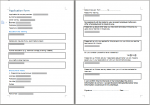Controlling-Absence-Policy

- Category:Performance Management
- Size:45 KB
- Format:doc
- Downloads:32024
Synopsis
Unscheduled absences are costly to business
Description
Managing absence
Managing attendance problems often means tackling possible causes of absence, such as working patterns, job design and employment relations. This can also include addressing discipline problems such as lateness and poor time keeping. If issues arise, they can often be dealt with informally by the line manager in the first instance.
Key points
- High levels of unauthorised absence, including sick leave can cause lost or delayed production, low morale and reduce the standard of service within an organisation.
- Measuring absence can show how much time is lost, where it occurs most and how often individual employees are absent.
- Keeping individual attendance records will help monitor absence and lateness.
- Having attendance and absence policies will help employees understand what standards are expected of them and will help managers deal with these issues in a fair and consistent way.
People are absent from work for 3 main reasons.
- They are sick.
- They feel unable to come to work because of family or caring responsibilities.
- They are on authorised leave such as holiday, maternity leave or a training course.
Unauthorised absence is normally the "odd day off" when employees give no reason for the absence. Whether paid or unpaid this type of absence can be costly to an organisation as it is unpredictable. Absence of this kind may eventually lead to disciplinary action.
How to minimise absence and lateness
In addition to carrying out effective return to work discussions, there are workplace issues that can be addressed to minimise absence. These include the quality of management, working relationships, job design, employment relations, communication of information and flexible working arrangements. In addition, if workers know that absence will be noticed and investigated, they are less likely to take time off work without proper cause.
Dealing with absence or lateness
Authorised absence and lateness can be dealt with by:
- requiring absent employees to phone in by a given time on each day of absence
- having a return to work interview to ensure there are no underlying issues
- taking disciplinary action if unexplained absence continues.
Related Resources

Induction Checklist Template
Starting Staffs

Employee Farewell Letter Template
Theme and Idea for Farewell Messages

Good Evaluation Letter Template
Compliment an Employee for a Positive Evaluation

Suspension Form Template
Investigation Prior to Taking Disciplinary Action Against an Employee
Top Resources

Employment Application Form Template
An Insight into a Job Applicant

Employee Welcome Letter Template
Welcoming the Fresh Men

Employee Referral Form
Referral programs can do wonders for Organisations

Employment Reference Check By Letter Template
References from former employers are likely to be more valuable than personal references and can help avoid negligent hiring claims.
